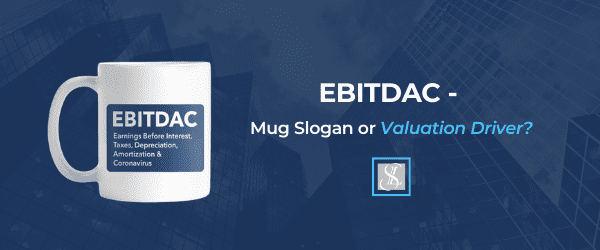 When buying or selling a company (now or in the future), it is important to recognize the impact that COVID has had on businesses. For most, COVID has had both positive and negative impacts on financial results. Darlene Leonard, Smith Leonard Transaction Advisors Practice Leader, recently participated in an event sponsored by ACG (Association for Corporate Growth) where a group of M&A professionals discussed EBITDAC (Earnings Before Interest Taxes Depreciation Amortization and COVID).
When buying or selling a company (now or in the future), it is important to recognize the impact that COVID has had on businesses. For most, COVID has had both positive and negative impacts on financial results. Darlene Leonard, Smith Leonard Transaction Advisors Practice Leader, recently participated in an event sponsored by ACG (Association for Corporate Growth) where a group of M&A professionals discussed EBITDAC (Earnings Before Interest Taxes Depreciation Amortization and COVID).
Ideas to consider in the new world of EBITDAC are below:
- Many companies are seeing revenue bumps as opposed to declines. While some of this may not result in a quality of earnings (QOE) adjustment, it may come into play for the valuation of the company
- In competitive situations, buyers are hesitant to not give the seller credit for some (or all) of the higher earnings, especially if they are afraid of losing the bid to another buyer
- Cost savings should be quantified where possible (i.e. deferred rent, reduced headcount, utility savings, travel, conferences, etc.). As you would expect – sellers aren’t inclined to volunteer this information or deduct from EBITDA, but buyers are trying to quantify where possible
- Additional costs should be tracked separately and added back to EBITDA (i.e. cleaning, testing, special bonuses to employees, surcharges, etc.). Compensation for people you kept on the payroll because of a PPP loan may be an addback or offset against the loan forgiveness income. However, be prepared to show past history of layoffs or reductions in workforce
- Projecting results will be important, and determining the “new normal” will be tricky:
- Will consumers continue to buy as much online?
- Will all or most employees come back into the office? Do I need all this office space?
- When will travel resume for meetings, customer visits, etc.? Or at what level will it resume?
- When will conventions return and at what level?
- What marketing techniques should I use going forward?
- What is the new normal? Is there a benchmark period (3 or 6 mos.) that I can extrapolate from? Consider carving out exceptionally high or low periods.
- Tracking key dates for shut-downs or stats on the wave of infection rates can help when looking back at financial results
- Trends will be a focus for any buyer and key performance indicators should be tracked, including:
- Backlog or pipeline trends for orders give visibility to future revenues
- Cancellations, returns, etc.
- Surcharges (i.e. freight) or one-time costs because of supply chain disruptions
- Concessions or temporary cost reductions
- Unit cost trends, price increases, etc. that impact margin
- Customer, segment, and geographic trends may be even more meaningful. Not every company was affected in the same way or at the same time
- Working capital trends should be reviewed closely when determining a target for purchase price negotiations. Did days sales outstanding spike for a period of time because of the uncertain environment?
- Altering the measurement period for an average may make sense instead of using a typical 12 month period
- Eliminate abnormal high or low periods
- What is the new or expected level of working capital needed?
As mentioned above, these items are important to think about whether you are considering a transaction in the near term or long-term. If you are a potential seller, documenting these adjustments while they are “fresh” will be easier than two years from now.
These are certainly interesting times, but the M&A world continues to be a busy one with a high level of interest for solid companies. Feel free to contact Darlene Leonard with any questions, comments, or example situations to ponder.
Meet Darlene and learn more about Smith Leonard’s Transaction Advisory Practice here.
